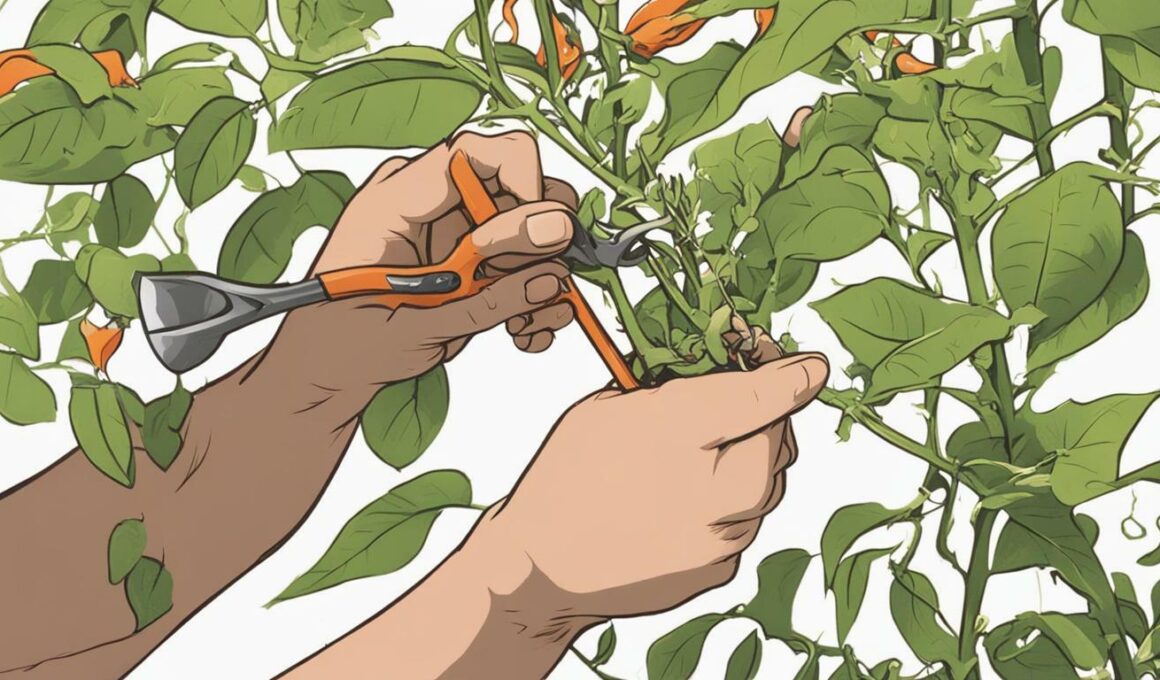If you have a trumpet vine with a crack, don’t worry! It’s a common problem, and it’s easy to fix. Trumpet vines are beautiful plants that can add color and life to any garden, but cracks can detract from their beauty and cause further damage if not fixed promptly.
In this article, we will provide you with an easy guide on how to fix a crack in a trumpet vine. We will help you assess the crack, provide a list of tools and materials needed for the repair, guide you through the step-by-step process, and offer tips and tricks to maintain a healthy trumpet vine.
Post Summary:
- A trumpet vine with a crack can be easily fixed.
- Cracks can detract from the beauty of a trumpet vine and cause further damage if not fixed promptly.
- We will provide you with an easy guide on how to fix a crack in a trumpet vine.
Assessing the Crack in Your Trumpet Vine
Before beginning the repair process, you need to assess the severity of the crack in your trumpet vine. Some cracks may be superficial and only affect the outer bark, while others may penetrate deeper into the wood.
The size of the crack is also a factor to consider. Larger cracks may require a different repair method or even professional assistance.
To assess the crack, start by examining the affected area closely. Look for any signs of damage or decay, such as discoloration, dryness, or softness. Try pressing on the surrounding wood – if it feels firm, the crack may not be serious.
If the crack is deeper and affects the internal structure of the vine, you may notice a bulging or swelling of the bark. This is a sign that the crack may be expanding as the wood contracts and expands due to temperature changes and humidity levels. If left untreated, this can lead to significant damage to the vine.
It’s important to address any cracks as soon as possible to prevent the problem from getting worse and potentially causing irreparable damage to your trumpet vine.
Tools and Materials Needed for Repairing a Crack in a Trumpet Vine
Fixing a crack in a trumpet vine requires the right tools and materials. Here’s what you need:
| Tools | Materials |
|---|---|
| Pruning shears | Flathead screwdriver |
| Hammer | Epoxy glue |
| Sanding paper | Cotton swabs |
Most of these tools and materials can be found at your local hardware store or online. If you don’t have access to epoxy glue, you can use a strong adhesive that’s suitable for outdoor use. Make sure it can bond to both plastic and wood, as that’s what the trumpet vine is made of.
Before you start the repair process, make sure all your tools are clean and sharp for optimal performance. A dull tool can damage the vine and make the problem worse.
Step-by-Step Guide to Fixing a Crack in a Trumpet Vine
Now that you’ve assessed the crack in your trumpet vine and gathered the necessary tools and materials, it’s time to start the repair process. Follow these step-by-step instructions:
- Prepare the affected area: Cut off any loose or damaged bark around the crack using a sharp knife or pruning shears. Be careful not to damage the healthy bark.
- Cleanse the area: Use a soft brush or cloth to gently remove any debris or loose bits of wood from the crack, ensuring that the area is clean and dry.
- Apply glue: Apply a thin layer of waterproof wood glue into the crack, using a brush or cotton swab to spread it evenly and fill any gaps.
- Wrap the area: Wrap the affected area tightly with grafting tape, starting from the bottom and working your way up. Make sure the tape is snug but not too tight, as it can damage the bark.
- Wait for the glue to dry: Allow the glue to dry completely, as per manufacturer’s instructions. This usually takes 24-48 hours.
- Remove the tape: Once the glue has dried, remove the grafting tape carefully, working from the top down. Be gentle to avoid damaging the bark.
- Seal the area: To protect the repaired area from moisture and insects, apply a coat of sealant or varnish to the affected area. This will also help restore the visual appeal of the vine.
And there you have it! Your trumpet vine should now be fully repaired and on its way to regaining its natural beauty.
Tip: It’s best to perform this repair during the early spring or late fall when the vine is less active and the risk of damage is lower.
Tips for Maintaining a Healthy Trumpet Vine
Caring for your trumpet vine properly can help prevent future cracks and ensure it remains healthy and beautiful. Here are some tips to keep in mind:
- Watering: Trumpet vines require regular watering during the growing season but can tolerate some drought. Water deeply and regularly, especially during dry spells, and avoid overwatering to prevent root rot.
- Pruning: Prune your trumpet vine in late winter or early spring to control its size and shape. Cut back any dead or damaged wood and remove any suckers or shoots from the base of the plant to prevent them from becoming a nuisance.
- Fertilizing: Trumpet vines don’t require additional fertilizer, but you can apply a slow-release or organic fertilizer in the spring to encourage healthy growth.
- Pests and Diseases: Keep an eye out for aphids, spider mites, and other common pests that can damage your trumpet vine. Treat them promptly with insecticidal soap or neem oil. Remove any infected plant parts to prevent the spread of disease.
- Sun and Soil: Trumpet vines prefer full sun and well-drained soil. If your soil is heavy or clay-like, amend it with compost or sand to improve drainage.
By following these tips, you can help your trumpet vine thrive and prevent future cracks from developing. Enjoy the beauty and charm of this lovely vine in your garden for years to come!
Common Mistakes to Avoid When Repairing a Crack in a Trumpet Vine
Repairing a crack in a trumpet vine can be a daunting task, especially if you don’t have the right tools and experience. Here are some common mistakes to avoid when fixing a crack in your trumpet vine:
Using the Wrong Materials
Make sure you use the right materials when repairing a crack in your trumpet vine. Using the wrong materials can cause more damage to your plant. For instance, you should use a sealant that is specifically designed for outdoor use and can withstand the elements. Avoid using tape or glue to seal cracks as they can damage the plant and hinder its growth.
Ignoring Safety Precautions
It’s essential to observe safety precautions when repairing a crack in your trumpet vine. Don’t attempt to fix the crack without wearing protective gear such as gloves and safety goggles. If you need to use a ladder, ensure it’s stable and secure before climbing. Additionally, ensure you are working in a well-ventilated space to avoid inhaling the fumes from the sealant.
Cutting Too Deep
When repairing a crack in your trumpet vine, avoid cutting too deep. Cutting too deep can damage the plant and cause more harm than good. Use a sharp cutting tool to remove any loose or damaged parts of the vine. Ensure you only cut away what is necessary to reach the crack.
Overwatering the Plant
Overwatering your trumpet vine can lead to the development of new cracks. It’s important to ensure that the soil is moist, not waterlogged. Be mindful of the amount of water you use and adjust accordingly, depending on the weather conditions. In hot and dry weather, you may need to water your plant more frequently.
Ignoring Other Issues
Don’t ignore other issues that your trumpet vine may have. Repairing a crack alone may not solve the problem. The plant may have other issues, such as pests, diseases, or poor soil nutrients, that can hinder its growth. Therefore, it’s essential to carry out a thorough inspection of the plant to identify any underlying issues and take appropriate action.
By avoiding these common mistakes, you can successfully repair a crack in your trumpet vine and help it thrive. Remember to follow the steps outlined in the guide and be patient, as it may take some time for the plant to fully recover.
Tips for Maintaining a Healthy Trumpet Vine
Now that you’ve successfully repaired the crack in your trumpet vine, it’s important to keep it healthy and prevent future damage. Here are some tips:
Proper Watering
Trumpet vines require regular watering to thrive, especially during the hot summer months. Make sure to water deeply and evenly, allowing the water to reach the plant’s roots. Avoid overwatering to prevent root rot.
Pruning
Regular pruning is essential for maintaining a healthy trumpet vine. Prune in late winter or early spring before new growth appears. Remove dead or damaged branches, thin out overcrowded growth, and shape the vine as desired.
Provide Support
Trumpet vines require a sturdy support structure to grow properly. Install a trellis or other support system that can handle the weight of the vine, and secure the stems to prevent them from breaking in the wind.
Avoid Overfertilizing
While trumpet vines benefit from regular fertilization, overfertilization can lead to excessive growth and weakened stems. Use a balanced fertilizer sparingly, and follow the manufacturer’s instructions carefully.
Monitor for Pests and Diseases
Keep an eye out for common pests and diseases that can affect trumpet vines, such as aphids, spider mites, and powdery mildew. Treat any infestations promptly to prevent damage to the plant.
By following these simple tips, your trumpet vine will remain healthy and beautiful for years to come.
FAQ
Q: How do I identify a crack in a trumpet vine?
A: Look for visible cracks on the stem or branches of the trumpet vine. It may appear as a split or separation in the wood.
Q: Can I repair a crack in a trumpet vine myself?
A: Yes, you can repair a crack in a trumpet vine yourself with the right tools and materials. However, if the crack is severe or extensive, it’s best to consult a professional.
Q: What tools and materials do I need for repairing a crack in a trumpet vine?
A: You will need a sharp knife or chisel, wood glue or epoxy resin, clamps, sandpaper, and a sealant. Make sure to gather all the necessary materials before starting the repair process.
Q: How long does it take to fix a crack in a trumpet vine?
A: The time it takes to fix a crack in a trumpet vine will vary depending on the size of the crack and the complexity of the repair. It can take anywhere from a few hours to a couple of days.
Q: How often should I water my trumpet vine after repairing a crack?
A: After repairing a crack in a trumpet vine, it’s important to water it regularly to promote healthy growth. Water the vine deeply once or twice a week, especially during hot and dry periods.
Q: Can I prevent future cracks in my trumpet vine?
A: While cracks in trumpet vines can occur due to natural causes or accidents, you can minimize the risk by providing proper support and regular maintenance. Avoid placing stress on the vine and inspect it regularly for any signs of damage.








